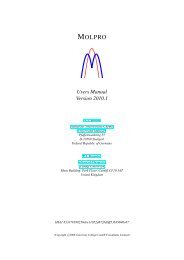Carbon−Carbon Coupling Reactions Catalyzed by Heterogeneous ...
Carbon−Carbon Coupling Reactions Catalyzed by Heterogeneous ...
Carbon−Carbon Coupling Reactions Catalyzed by Heterogeneous ...
Create successful ePaper yourself
Turn your PDF publications into a flip-book with our unique Google optimized e-Paper software.
<strong>Heterogeneous</strong> Pd <strong>Catalyzed</strong> C−C <strong>Coupling</strong> <strong>Reactions</strong> Chemical Reviews, 2007, Vol. 107, No. 1 169<br />
Scheme 61. Pd(NH3)4 2+ /(NH3)Y-<strong>Catalyzed</strong> Synthesis of<br />
2-Phenylbenzo[b]furans<br />
Table 85. Pd/C-<strong>Catalyzed</strong> Synthesis of 3-Substituted<br />
Isocoumarins a<br />
a All reactions were carried out using iodide (1.0 equiv), alkyne (2.0<br />
equiv), Et3N (5.0 equiv), and a 1/4/2 ratio of 10% Pd/C (3 mol %),<br />
PPh3, and CuI, in EtOH for 16 h. b Isolated yields.<br />
In this way, 1,2-diphenylethanes 236 and 237 were obtained<br />
from styrene and bromobenzene or o-bromonitrobenzene,<br />
respectively (Scheme 62). 271<br />
Scheme 62. One-Pot Synthesis of 1,2-Diphenylethanes 236<br />
and 237<br />
Pd/C-catalyzed Heck coupling was further combined with<br />
subsequent Suzuki coupling in order to synthesize 4-styrylbiphenyl<br />
240, a substructure of pharmaceutically active<br />
compounds. 271 Because Heck coupling is more selective for<br />
different leaving groups than Suzuki coupling, the Heck<br />
coupling was applied as the first reaction step and Suzuki<br />
coupling as the second (Scheme 63).<br />
Scheme 63. Pd/C-<strong>Catalyzed</strong> One-Pot Synthesis of<br />
4-Styrylbiphenyl 240<br />
10. Conclusions and Perspectives<br />
Nowadays, Pd-catalyzed homogeneous coupling reactions<br />
belong in the toolbox of each synthetic organic chemist and<br />
have been used in many fields of organic synthesis leading<br />
to products of various interests. However, industrial applications<br />
of these reactions are still challenging because the<br />
catalysts are expensive, cannot be recycled, and are difficult<br />
to remove from the product. The latter fact is a drawback in<br />
particular for pharmaceutical industries.<br />
Although Pd fixed on inorganic and organic supports have<br />
been known for a long time and applied to C-C coupling<br />
reactions in single cases more than 30 years ago, their<br />
versatility has only recently been shown in almost all types<br />
of C-C couplings during the last decades. This methodology<br />
has not been appreciated <strong>by</strong> many organic chemists so far.<br />
In most cases, their first choice is homogeneous Pd catalysts.<br />
The heterogeneous methodology offers a number of<br />
advantages such as high stability of the catalyst, easy removal<br />
of the catalyst from the reaction mixture <strong>by</strong> filtration,<br />
reusability of the catalyst for several times with often<br />
minimal loss of activity, and, remarkably, a better performance<br />
than homogeneous Pd catalysts in a considerable<br />
number of cases. On the other hand, catalysis <strong>by</strong> Pd on solid<br />
supports can require higher reaction temperatures and have<br />
limitations in stereoselective reactions. Pd catalysts supported<br />
<strong>by</strong> inorganic and organic materials can also offer the<br />
possibility of circumventing ligands such as phosphines or<br />
arsines in certain cases and often do not need water- and<br />
oxygen-free conditions.<br />
The majority of catalysts applied so far are Pd/C catalysts,<br />
which are commercially available in most cases and can<br />
directly be used. Other supported Pd catalysts have to be<br />
prepared <strong>by</strong> the user. They can provide advantages over Pd/<br />
C, and they can allow tuning of the properties of the catalyst.<br />
Many activities can be expected in this field in future.<br />
The mechanism of most of the coupling reactions catalyzed<br />
<strong>by</strong> solid-supported Pd is still unclear. Future research in this<br />
field will help the understanding of the sometimes contradictory<br />
results in this field. It has been increasingly accepted<br />
that most heterogeneous Pd catalysts catalyze in a homogeneous<br />
way <strong>by</strong> leached Pd species, which can re-deposit when<br />
the reaction comes to an end. However, general conclusions<br />
are difficult to attain because in most cases the mechanism<br />
of a certain reaction is affected <strong>by</strong> the conditions very much.<br />
Although there are also other modern trends in Pd<br />
catalysis, such as polymer-supported Pd, Pd nanoparticles,<br />
or Pd clusters, it can be expected that the application of Pd<br />
supported <strong>by</strong> inorganic materials will gain increasing importance<br />
and application in future.












![Hetero [6+3] Cycloaddition of Fulvenes with N-Alkylidene Glycine ...](https://img.yumpu.com/35423358/1/190x245/hetero-6-3-cycloaddition-of-fulvenes-with-n-alkylidene-glycine-.jpg?quality=85)




